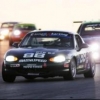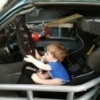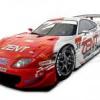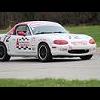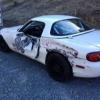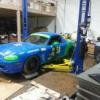
Roll cage and crumple zones
#1

 Posted 10-20-2013 10:30 AM
Posted 10-20-2013 10:30 AM

Looking for input here and yes I will also be running a full containment seat.

#2

 Posted 10-20-2013 11:05 AM
Posted 10-20-2013 11:05 AM

fwiw...
With the TC Design cage in my car, the rear bars stop just after the shock towers. I presume that is for the reason you mentioned - allow the tub to crumple before making contact with the cage and transferring energy through the rest of the car.

#3

 Posted 10-20-2013 11:29 AM
Posted 10-20-2013 11:29 AM

My cage designed by "Bench" has rearward tubes that end at a pad just after the shock mount with angled tubes from the same rear pad traveling to the middle of the main hoop horizontal which has a Petty tube traveling to the base of the front left down tube. It's been tested when someone used the rear of the car for his brakes. As the rear verticle panel of the trumk caved in, the floor of the trunk crumpled and the left rear inverted chassis "U" bent downward left and upward from inside the trunk. Frame machine pulled it back to as good as new other than my newly painted trunk now looks well used. And before the frame machine the the car swas cornered, alignment/camber was checked with all being as good as when it ws originally done.
The car ready to race without driver and added weight is 2020 pounds,



#4

 Posted 10-20-2013 01:59 PM
Posted 10-20-2013 01:59 PM

Hey Paul, Great post, safety 1st, etc...
I don't know your situation, condition of your car, etc.
Just one thing that comes to mind that's a little a off topic.
I see the wrecks as an issues and should be reviewed or you may have the same result with your new build.
Reviewing your wrecks for, If I or my car only did this maybe I wouldn't of been in that position.
Better setup, if I was coached/data being faster, Patients and get them on the next lap, reading traffic, whatever the case.
I understand everyone has a bad season, crap happens etc.
Good luck.
![]()
J~








#5

 Posted 10-20-2013 05:18 PM
Posted 10-20-2013 05:18 PM

- Muda likes this

#6

 Posted 10-21-2013 09:00 AM
Posted 10-21-2013 09:00 AM

Paul,
I can only talk to your last wreck, as I was not present at the others. I spent a lot of time looking over your car, and it would appear that the cage did it's job, as did the front crumple zone. There was little to no intrusion into the driver compartment, even thought the front of the car was severly crushed. The thing that I still wonder about is how contact was made with the steering wheel, especially since you wear a HANS. As far as increased safety in that type of frontal crash, I would be looking at how well the harness and HANS performed or didn't perform. It might also be a question of steering wheel location. They make steering wheel adapters for racing that have a built in crumple zone. Might be worth looking at. Also, I don't remember if you had a 2" or 3" lap belt, but a lot of the manufactureres are claiming the 2" lap belts are safer. When I first starting racing up at Waterford Hills, the officials would go around and check everyone's belts before you went out on track, making sure they were sinched down super tight. A simple thing, but critical to the belts offering the best protection possible.
Marc
#7

 Posted 10-21-2013 09:36 AM
Posted 10-21-2013 09:36 AM

Also look into a full containment seat. BEst of luck
Jim
East Street Auto Parts
Jim@Eaststreet.com
800 700 9080













#8

 Posted 10-21-2013 10:22 AM
Posted 10-21-2013 10:22 AM

You're not going to get a full answer on this board for the concerns you have. The subject is too complicated.
You say, you want to build a car that is strong. Strong does not necessary mean safe. Not that long time ago we were building strong (too strong) cars that resulted in more fatalities, as these cars were not able to disintegrate and dissipate the energy before it "got" to the driver. Adding multiple tubes blindly could result in a car that is too strong, because you must remember the car's from the 90's do not disintegrate as well as newer cars.
There is a guy in North East that travels to events, watches wrecked cars, measures, recalculates and builds cages. I saw his works once, and I have read his explanations for the work he was doing. I thought he was a genius. See if you can find him, he would help.
I saw both of your crashes online, and both times, the biggest problem was not the cage, even though it should never break. Your problem was: ARMCO barriers, and rapid deceleration. Both are super dangerous. ARMCO barriers release the energy back, and the car is spit out back onto the track. Both of your crashes, mine crash, and every other time this year I have seen a car hit an ARMCO barrier (WGI, LRP), it ended back on the race track, or more. There was a big discussion about ARMCO barriers at WGI started by Jeff Gordon. You can read and learn interesting stuff there.
The rapid deceleration, which causes deceleration trauma is the tricky one. There is no single safety device for it. During a crash everything stops. Sometimes the "stopping" will take long, which is good, but sometimes it's instant like in your case. Those are the worst as there is very little time to dissipate the energy. Even though the cage will do it's job, the belts along with the HANS will hold you from making any kind of impact, you still can be hurt. That is, because there is nothing from stopping your internal organs from moving. Brain floats inside the skull, heart is not bolted to anything in the body, and other organs are also vulnerable. Full halo seat, or HANS device does not help in this scenario. Only the seat belts are actually designed to stretch during the impact in order to extend the time of deceleration.
Safety of a race car is build around a balance between many things, and you can't offset the balance by adding too many cage elements without knowing how it's going to affect your car.
* Every rapid deceleration hit requires an MRI for the driver even if he is "fine".
#9

 Posted 10-21-2013 11:00 AM
Posted 10-21-2013 11:00 AM

Your problem was: ARMCO barriers, and rapid deceleration.
Yes, totally agree which is why I'm looking very carefully a cages because they affect energy absorption. In my blue car the left rear corner was crumpled up to the welded plate at the base of the cage down tube. I'm looking at a caged tub right now which has that plate back about 8 or more inches and I'm wondering if that energy absorption would be compromised. And to Jim's point , the most recent cage had very little side support which made me nervous since my shoulder and upper torso would be completely exposed in a side impact. I was fortunate that wasn't the case. My next cage will have 3 row Nascar bars on both side.
In both wrecks the cages did what they were supposed to but there was potential for more damage. I want to make sure I get this right.

#10

 Posted 10-21-2013 11:04 AM
Posted 10-21-2013 11:04 AM

In my blue car the left rear corner was crumpled up to the welded plate at the base of the cage down tube.
I'm looking at a caged tub right now which has that plate back about 8 or more inches and I'm wondering if that energy absorption would be compromised.
Point one had crumple zone.
Point two has less crumple zone.
- AW33COM likes this



#11

 Posted 10-21-2013 03:02 PM
Posted 10-21-2013 03:02 PM

I always thought the Aarmco at NE tracks was way too close. Not enough runoff at either WGI or LRP.
- AW33COM likes this

#12

 Posted 10-22-2013 07:35 AM
Posted 10-22-2013 07:35 AM

My next cage will have 3 row Nascar bars on both side.
If you're going to build a custom cage you may as well design the best one there is. For side impact I would run a double wall: 3 bar Nascar cage with 3 straight bars on the inside. On the left side where your heart and abdominal is I would weld in metal plates to the 3 straight pipes. Bars if possible should be hard padded with soft padding on top of it.
Mild steel cage MIG welded. Laser cuts would be best. No S bands, no dead tubes. No X braces. No tube intersections. Gussets to support the cage. Container for the kill switch. Knee bar. Petty bar. Good roof support. Landing perches. Seat belt cage support. Camera support. Seat as low as possible (RaceTech seats are tight and your body will be farther away from the door than in a Sparco seat). Floor support.
#13

 Posted 10-22-2013 07:47 AM
Posted 10-22-2013 07:47 AM

Keeping in mind GCR compliance, of course. (I don't believe we are permitted to reinforce the floor, for instance)


#14

 Posted 10-22-2013 10:08 AM
Posted 10-22-2013 10:08 AM

I just got back from Thunderhill testing for the 25 hours. I actually remember how to work on a V8 Mustang !!!!!
I did a few minor changes to our Miata roll cage this past 6 months. A little bigger here, a little smaller there. And we brought all our tube bending in house for better quality control and on time availability. We did a few cages this summer with the new design. Including both Tom Browns 2 week build and Voyteks new Runoffs cars. We have 2 new builds getting started after we return from the ARRC. We will be putting up new pix and a video of the new design.
I am not a structural engineer, but I understand triangles and have seen a lot of race crashes. So here is my reasoning behind my design decisions.
Protect the driver
When ever possible, tie the roll cage into the strongest part of the car. In our case, the rocker panel.
When ever possible, do not put the roll cage in single shear, try to make a 3 dimensional connection. Avoid square cut tube welded to a flat surface.
Protect the driver
Form a survival cell with the tubing around the driver. No gaps between tubes when ever possible. No "S" bends (single shear) in the door bars.
Knee or dash bar should be a required bar, not optional.
Bring the rear down tubes back into the trunk. Have a crossbar in the trunk connecting the 2 rear down tubes. Have a diagonal bar going from above drivers head into trunk, connecting to cross bar (near battery)
Have as much left foot room as possible and make sure factory dead pedal is functional.
Protect the driver
Route seat belts properly
proper padding
We had some really big hits this summer at Road America. One write-off and 4 major repairs in one race. No drivers where injured because of proper safety precautions and equipment where utilized.
I just returned from Thunderhill. I don't know if the quality of cars at this particular race is an accurate sampling of the local cars. But I would not race half the cars at the track. Minimalist bolt in cages, no padding, wires hanging everywhere. Now there where a couple nice cars. The white one that had a Miata on his hood can attest to why a good cage is not an option.
Dave
- Parity likes this
Dave Wheeler
Advanced Autosports, the nations most complete Spec Miata shop
Author, Spec Miata Constructors Guide, version 1 and 2.0
Building Championship winning cars since 1995
4 time Central Division Spec Miata Champion car builder 2012-2013-2014-2017
Back to Back June Sprints Spec Miata 1-2 finishes 2016 and 2017
5 time June Sprints winner in Mazda's
6 Time Northern Conference Champion Car Builder
2014 SCCA Majors National point Champion car builder
2014 SCCA Runoffs winner, T4 (Bender)
2014 Central Division Champion, ITS (Wheeler)
2013 Thunderhill 25 hour winning crew chief
2007 June Sprints winner, (GT1, Mohrhauser)
Over 200 race wins and counting.
www.advanced-autosports.com
dave@advanced-autosports.com
608-313-1230





#15

 Posted 10-22-2013 11:02 AM
Posted 10-22-2013 11:02 AM

#16

 Posted 10-22-2013 11:39 AM
Posted 10-22-2013 11:39 AM

Dave,
The BRAND NEW White 99 that you saw in the impound area was mine, and I am planning a post in regards to the accident and the safety equipment that did/did not work. I am REALLY lucky that I did not sustain some serious bodily injury, as the front passenger tire of the accident causing miata was IN my drivers compartment!
Short recommendation, Safety First
Rusty


#17

 Posted 10-22-2013 11:48 AM
Posted 10-22-2013 11:48 AM

Dave,
The BRAND NEW White 99 that you saw in the impound area was mine, and I am planning a post in regards to the accident and the safety equipment that did/did not work. I am REALLY lucky that I did not sustain some serious bodily injury, as the front passenger tire of the accident causing miata was IN my drivers compartment!
Short recommendation, Safety First
Rusty
You just got yours going and crashed it too ??
As bad as Juans ??
Yes, maybe start a thread.
J~








#18

 Posted 10-22-2013 11:58 AM
Posted 10-22-2013 11:58 AM

To the OP's original question, I had the same concern when designing my cage and had conflicting opinions from people I respect greatly. Ideally the cage should be large enough to protect the driver from intrusion but no so large that it eliminates all energy dissipation before force gets to the cage. Regarding the rear bars, I felt there was enough cage between the driver and the potential impact that I did not need to extend the rear diagonals past the rear subframe. I didn't see how extending them past the subframe would be of much benefit in rigidity either. This leaves the rear crumple zone unaltered and allows easier repair from a big rear hit since the cage is less likely to be damaged and the rear of the car can be clipped. That said, two bars are not going to stop the crumpling dead in its tracks, just slow it a little.
Here's what I did. For more detail click on my build thread link.
It's not possible to get the diagnonal down to the horizontal piece due to the gas tank.





#19

 Posted 10-22-2013 12:16 PM
Posted 10-22-2013 12:16 PM

#20

 Posted 10-22-2013 01:22 PM
Posted 10-22-2013 01:22 PM

NO Johnny, I just got mine going and got "taken out"......
Oh, "taken out", dinner and a movie ??
Sorry to hear. Were you getting ready for the 25 ?
J~








1 user(s) are reading this topic
0 members, 1 guests, 0 anonymous users




 Sign In
Sign In Create Account
Create Account



 Back to top
Back to top Report
Report


